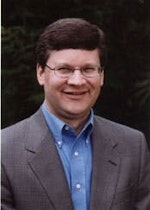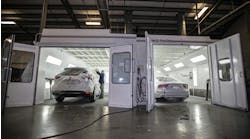Anyone who has done it will tell you: There’s no better way to get great ideas for your business than paying a visit to another successful shop. No matter how long you’ve been in business, no matter how much bigger or smaller your shop is, no matter how different your market may seem, you’re bound to come away with something you can use to improve your business.
Here’s a sampling of 10 of the types of ideas you might pick up by taking some time to stop in and talk to a fellow shop owner.
1. One-day and even same-day repairs have become regular occurrences through a “rapid repair” system established at Top Finish Collision Center in Santa Ana, Calif.
“I understand that insurance companies want us to provide ways to improve the customer experience,” shop owner Tony Bucio said. “I built that (rapid repair) area to have a team of people to do repairs that are typically small or medium, and get those cars in and out. We don’t have the heavy-frame machinery there. We don’t slow down big jobs by asking our most experienced technicians to do the small jobs, and we don’t slow down the small jobs because we’re handing the big jobs. We have two teams of people.”
For the smallest jobs – a bumper replacement, for example – the shop often paints the part before the customer arrives; the shop may remove the vehicle’s fuel door when the vehicle is first at the shop to use, along with the paint code, to match the paint.
“So literally, the customer arrives, sits down in our waiting room, and we exchange the bumper in a matter of minutes,” Bucio said. “We bring the car back, washed and clean, and in a matter of 30 or 45 minutes we have a job done. The customer is extremely happy, and the insurance company is happy.”
“We took it upon ourselves to get the word out that we are good,” said Burge, who manages the shop for a group of dealerships. “So every customer as they are leaving us gets a hand-out with directions on how to go to that website and give us a review, good or bad.”
Fortunately for the shop, the vast majority of those reviews are good, with nearly 96 percent giving the shop a 4- or 5-star rating. That genuine customer feedback is convincing others to bring their vehicles to the shop.
“We have a car in here from hundreds of miles away in New Mexico right now,” Burge said. “The owners are in town visiting family and wrecked their car, and after they went online, hands-down they came here. That kind of marketing doesn’t cost anything.
3. Mike Schoonover is quite frank about the downturn his two-shop business in Minnesota has been experiencing as the U.S. economy continues to sputter.
“We’re taking ‘lean’ to an extreme,” Schoonover said, citing a decrease in sales over an 8-10 month period earlier this year. “It’s based on the weather and other issues taking place within our local markets here. So we’re looking to cut different costs. Unfortunately, we’re eliminating people and having individuals take on more responsibility. We look at everything and say just because we’ve done something year after year, that doesn’t mean that it’s right. So we’ve just reexamined everything and reinvented ourselves.”
Is there a specific expense he determined the business needed to do without?
“We used to have a driver and a flatbed (tow truck) to transport vehicles to and from our locations,” Schoonover said. “It would pick up and deliver customer vehicles, and pick-up and deliver vehicles to and from our dealership accounts. But we had to eliminate that whole service. We’ll still do it, but we don’t do it as often.”
Schoonover, whose family has operated the business since 1938, said that while the changes have not been easy, he thinks his business is now better prepared to prosper as the economy continues to rebound and sales improve.
4. Second-generation shop owner Mike Young of Atomic Auto Body in Richland, Wash., said his shop offers its customers a free detail of their repaired vehicle four times a year for as long as they own it. The shop currently has more than 500 customers signed up on the service, and typically does three such details per day and is booked out a month in advance. Young pulls a small percentage of the shop’s labor sales to help offset some of the cost of his detail department, which also does retail work, including added detail services for customers in for the free basic detail.
“The detail department generates about $8,000 a month in sales, which isn’t too bad for two stalls,” Young said.
So does the free detail work pencil out for the business? Young said like all marketing, it can be hard to gauge, but he prefers to spend marketing dollars in ways that benefit his existing customers and distinguish his shop from others.
“It allows us to reach out and touch that customer in a positive way,” Young said. “We see them quarterly, and if I didn’t have that program, I probably wouldn’t have any contact with them between accidents. And people do appreciate a clean car.”
5. John Borek has found some creative ways to generate publicity for his 22-employee shop, Autocraft Bodywerks in Austin, Texas, including converting a C4 Corvette into a working replica of the Batmobile. But he’s also found some unique ways to generate revenue, including selling golf carts customized to look like a Hummer, an Escalade, a 1932 Ford or a Bentley.
I just sold one last Christmas to the woman married to (pro tennis player) Andy Roddick,” Borek said. “I sold one to (American Idol winner) Kelly Clarkson. I sold one to (Desperate Housewives actress) Eva Longoria who bought it for Tony Parker (of the San Antonio Spurs) before they got divorced. So you get to meet some cool people, too.”
Borek said he uses a website to market the carts, which are built by another company, but which his shop often customizes with special wheels or paint to match the buyer’s regular vehicle.
“Anyone who can afford a $10,000 or $15,000 golf cart can pretty much afford anything,” Borek said. “And it’s actually pretty profitable. If I sold four carts a month, I’d make more than I do from this whole shop.”6. Darren Pierse, co-owner of Arizona Collision Specialists in Scottsdale, Ariz., said one way he saw to improve his company’s “touch time” on vehicles would be an additional parts delivery, essentially overnight, so that his techs could hit the ground running with those parts the next morning.
Pierse spoke with a multi-line dealer, who proposed that in addition to its regular deliveries, all of its dealerships would make a late-in-the-day delivery of the shop’s parts to a central hub; Arizona Collision Specialists uses a third-party to pick up those parts overnight and deliver them to Pierse’s shops by 6 a.m.
There were some logistics issues to work out. Pierse, for example, didn’t want to allow access to the shop overnight when no one was there. But some shop office space with outside access that could be locked off from the rest of the shop was converted to an overnight drop-off point.
Latuff said the shop also has a meticulous system related to clips and fasteners. When the blueprinter disassembles a vehicle, for example, all fasteners are placed in a plastic box with numbered compartments. A fastener box for a front bumper, for example, includes a generic photo of a front bumper, showing that the fasteners from the top center of the bumper cover, for example, are in compartment No. 1 of the box, the bolts going into the fenders are in compartment No. 2, etc. This allows whoever is reassembling the vehicle to locate the needed fasteners quickly.
If the blueprinter can’t find necessary replacement fasteners within the shop’s supply, he uses the electronic parts catalog to get the right part number and list price. He also puts a sample of the fastener in a plastic bag marked with a pink X (the shop’s visual cue for “replace”) along with the numbers that are needed. When those parts arrive, the person mirror-matching the parts can compare them to the sample, ensure the correct number arrived, and put them with the rest of the parts for that job.8. Doug Verdier of Active Auto Body said that although he’d like a newer building to improve the flow of production, he wouldn’t want to give up his shop’s great location in downtown Portland, Ore., close and convenient to his core clientele, who tend to drive upper-end European vehicles.
Like a lot of shops in urban areas, Verdier’s company struggles with a shortage of outside parking for vehicles. But he found one creative solution that’s helped: He worked out a deal with a nearby church to use its parking lot during the week in exchange for the church using his lot on Sundays.
9. Geralynn Kottschade said that she her husband Jerry try to teach their 22 employees at Jerry’s Body Shop in Mankato, Minn., by example. They demonstrate, for example, the respect for others that they expect their employees to show not only to each other and to customers, but also to other repairers in their market, and to insurers or desk auditors.
“We may not always like them, but you have to respect them.” Kottschade said. “That seems to be something that gets lost sometimes, the professional courtesy that should exist within the collision industry.”
If the shop is re-repairing a vehicle from another shop, that’s something that is done respectfully and confidentially, Kottschade said.
“Our job is to just fix it and make it right, and remember that someone else might someday be correcting a mistake we make,” she said.
Avoiding any such mistakes is part of the Kottschades’ belief in the three Ts: training employees, tooling them and trusting them. Every employee knows they are empowered to stop a vehicle at any point in the process if they see something that’s not right, she said.
“We created an environment for employees that at the end of the day, they can go home knowing they did the best job, not doing anything substandard or that compromises their morals,” she said. “They need to feel safe and that we are doing the right thing.”
One way the Kottschades provide information to their employees is by providing each of them with an email address. Kottschade said she can use those addresses to forward information – whether about a new product, or a link to a helpful trade publication article – to them.
10. Rick Stoker, manager of the Dick Hannah Collision Center in Vancouver, Wash., said his shop was among the first in the state four years ago to switch to waterborne basecoats. He wants to make sure the shop uses virtually every drop of the system’s toners, so he’s set up a way to ensure that happens.
“Empty” containers are recapped and tossed into a storage container within the paint shop. A non-production employee is then charged with turning those containers upside down overnight, so that any remaining liquid ends up in the cap. The “remnants” of a given toner are then poured into a corresponding toner container. Capful by capful, Stoker said, the shop can actually “rescue” as much as another full container of any particular toner.
Stoker said the system has actually helped get a job out when a painter realizes (too late for a same-day delivery from the shop’s paint vendor) he doesn’t have quite enough of a toner for a job – but can check the “back shelf” to pull what’s been recaptured from previous “empty” containers of that toner.
Subscribe to ABRN and receive articles like this every month….absolutely free. Click here.







